Filipino cuisine offers a delightful mix of flavors and ingredients that reflect the country’s rich history and diverse cultural influences. From savory dishes to sweet treats, each recipe brings something unique to the table. Exploring these recipes allows you to experience the vibrant and authentic taste of the Philippines right in your own kitchen.
Whether you’re new to Filipino food or a seasoned fan, these dishes are sure to impress. The variety ensures there’s something for everyone, showcasing how different ingredients can come together to create unforgettable meals.

1) Adobo
Adobo is one of the most well-known Filipino dishes. It is recognized for its flavorful and savory profile. The dish mainly consists of meat, usually chicken or pork, marinated in a mix of vinegar, soy sauce, garlic, and spices.
You cook the marinated meat to tender perfection. The marinade helps to preserve the meat, and the result is a dish with a rich, umami flavor. Adobo can also include vegetables like potatoes, which soak up the flavors of the sauce.
There are many variations of adobo. Some recipes use coconut milk to add richness or spicy peppers for a kick. Others incorporate unique ingredients like mole crickets, showing the adventurous side of Filipino cuisine.
Adobo is often served with steamed rice, allowing you to savor every bit of the sauce. Each region in the Philippines has its own take on adobo, making it a versatile and much-loved dish.
No matter the variation, adobo remains a staple in Filipino households and is a must-try for anyone exploring Filipino cuisine.
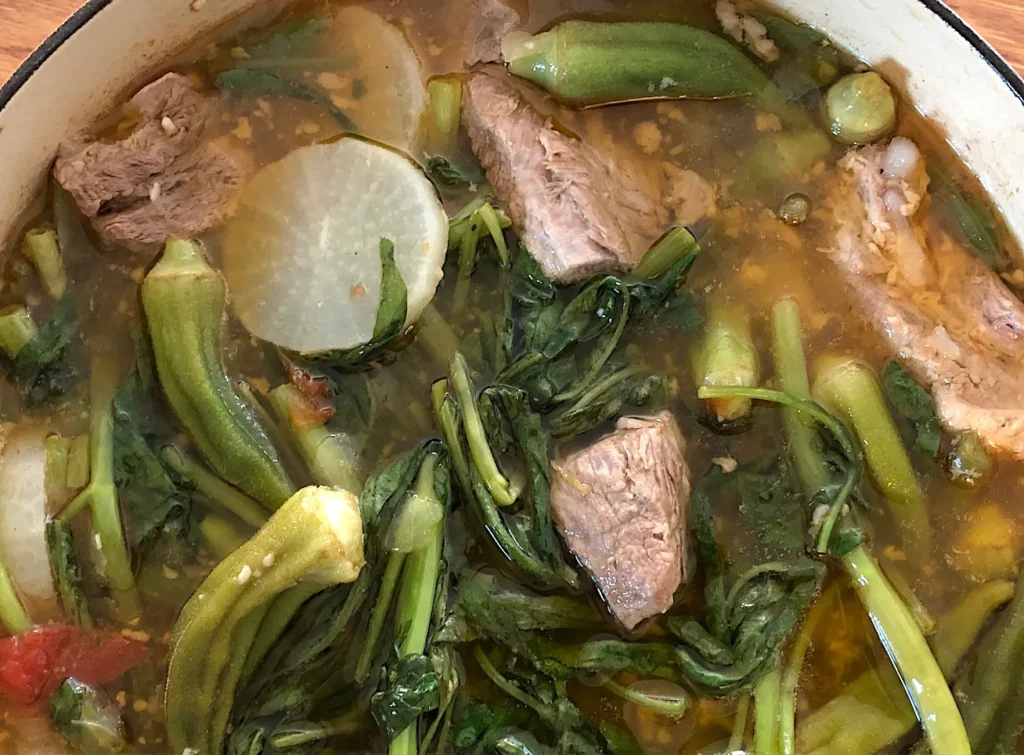
2) Sinigang
Sinigang is a classic Filipino soup known for its sour flavor. This dish often uses tamarind, which gives it its distinct tang. You start by boiling water and adding your main ingredient, usually pork, to the pot.
Next, add onions and tomatoes to the boiling water. These veggies add depth to the broth. Simmer until the pork is tender, which usually takes about 1 to 2 hours.
You’ll also need to add other vegetables like eggplant, okra, and green beans. These enhance the dish with different textures and flavors. Don’t forget the fish sauce, which adds a salty punch.
If you’re using gabi, a type of taro, include it for a thicker soup. Let it cook until tender. Adjust the sourness by adding more tamarind or other souring agents like green mangoes or calamansi.
Serve your Sinigang hot with a side of steamed rice. You’ll find that the combination of sour broth, tender meat, and variety of vegetables creates a comforting and flavorful meal.
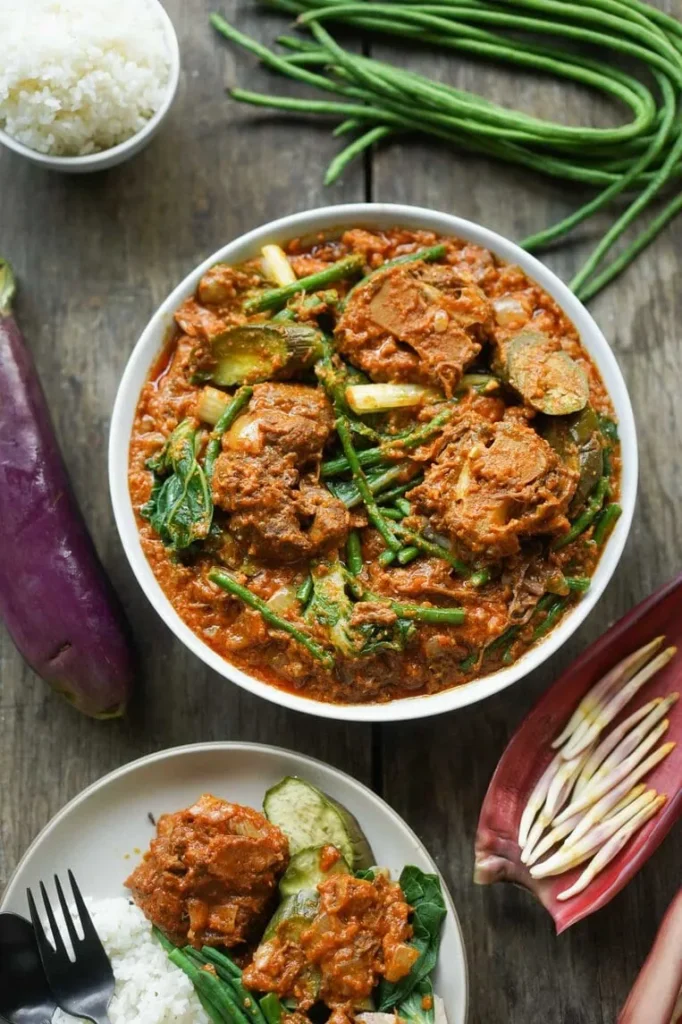
3) Kare-Kare
Kare-Kare is a classic Filipino stew known for its hearty flavors and rich peanut sauce. This dish often features oxtail, beef tripe, and vegetables like eggplant, banana blossom, and string beans. Traditionally, it’s served with bagoong, a flavorful shrimp paste, on the side.
To start cooking, blanch the oxtail, beef chunks, and tripe in boiling water for about five minutes. This step helps remove impurities from the meat. Rinse the meat in cold water and set it aside.
In a large pot, heat some oil and saute onions until they are soft. Add garlic and cook briefly. Next, pour in a mixture of simmering stock and peanut butter. Stir until well combined. Add the meat back into the pot and let it simmer until tender.
Annatto powder is often used for color, mixed with broth before adding to the pot. Toasted rice flour can also be added to thicken the sauce. Stir everything together, ensuring the sauce is smooth.
Once the meat is tender, add the vegetables. Cook until they are just done, keeping them vibrant and crisp. Serve your Kare-Kare hot with a side of bagoong for an authentic Filipino dining experience.

4) Lechon
Lechon is a famous Filipino dish, usually served at large gatherings and celebrations. It is a whole roasted pig, known for its crispy skin and juicy meat. Preparing lechon is a meticulous process that starts with marinating the meat to bring out its rich flavors.
For a more manageable version, you can make Lechon Belly. This dish maintains all the wonderful flavors of traditional lechon but uses pork belly instead. You will need to season it with salt, pepper, garlic, and other spices. Then, stuff it with ingredients like lemongrass, onions, and bay leaves.
Cooking the Lechon Belly requires slow roasting. First, you bake it at a low temperature to cook the meat thoroughly. Then, increase the heat to achieve that coveted crispy skin. This ensures that the meat stays tender while the skin gets crunchy.
Lechon can be enjoyed in many ways. You may serve it with a dipping sauce made from vinegar, soy sauce, and chopped chilies. It’s often accompanied by steamed rice or other Filipino side dishes. Lechon Belly is a centerpiece dish that will impress your guests with its tantalizing taste and delightful texture.
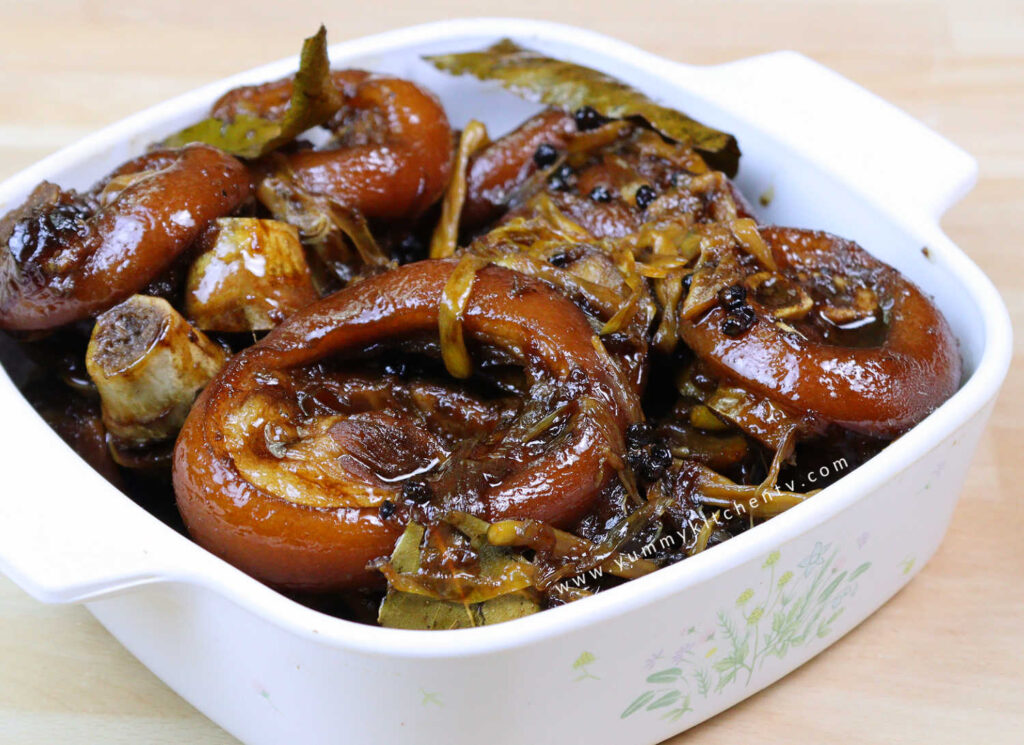
5) Paksiw na Pata
Paksiw na Pata is a savory Filipino dish made with pork hock. The pork is typically braised in vinegar and soy sauce, giving it a rich flavor.
To start, boil the pork hock for about 15 minutes. This helps remove impurities. Once done, discard the boiling water and rinse the pork.
In a pot, heat some oil and sauté garlic and onions until soft. Add the pork hock and brown it on all sides. This step enhances the meat’s flavor.
Next, add vinegar and let it boil without stirring for a few minutes. Incorporate soy sauce, whole peppercorn, and dried bay leaves. Simmer the mixture for 1 to 1.5 hours or until the pork is very tender.
To get a thicker sauce, you can add banana blossoms in the last 5 to 7 minutes of cooking.
Serve Paksiw na Pata with steamed rice to enjoy its full flavor.
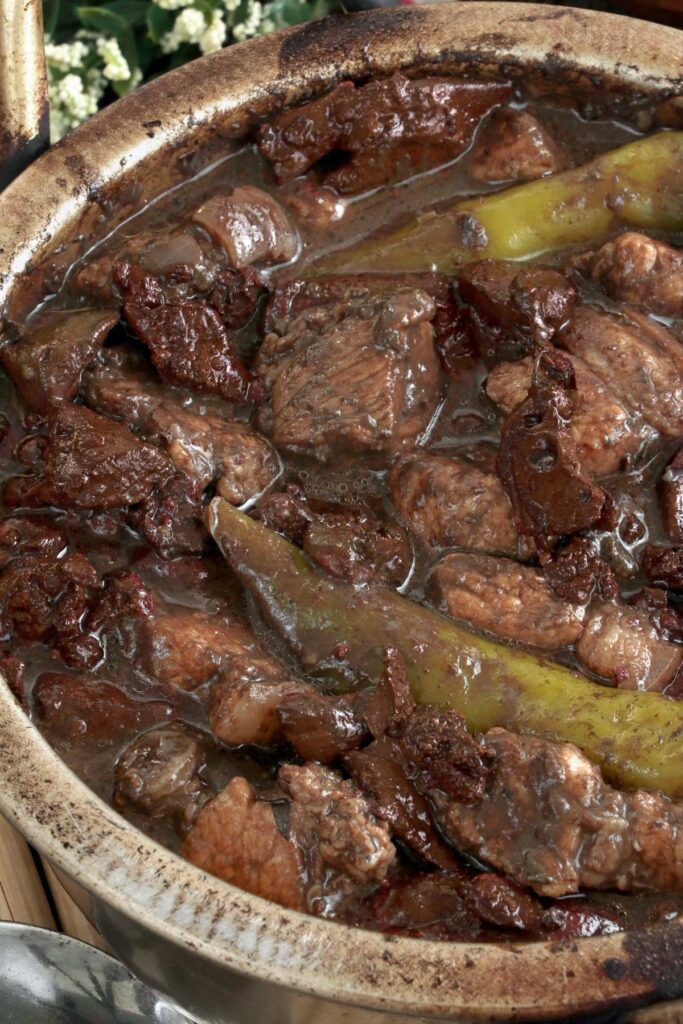
6) Dinuguan
Dinuguan, also known as pork blood stew, is a rich and savory Filipino dish. It’s made from pork and pig’s blood, simmered with vinegar and spices.
To start, mix pig’s blood with vinegar. This helps prevent coagulation. Heat oil in a pot and sauté onions, garlic, and ginger until soft.
Add the pork pieces and cook until they are browned. Then, add fish sauce and let it cook for a minute.
Pour the blood mixture into the pot while stirring. This thickens the stew and gives it its unique flavor. Add vinegar, bay leaves, and let it simmer without stirring.
Cook the mixture until the pork is tender and the sauce thickens. Season with salt and pepper to taste.
Serve Dinuguan hot, often with steamed rice or puto (Filipino rice cakes). The combination of tangy, savory flavors makes it a unique dish to try.

7) Bicol Express
Bicol Express is a spicy and creamy Filipino dish named after a train route in the Bicol region. It combines pork belly with a flavorful mix of coconut milk, shrimp paste (bagoong), and chili peppers.
To make Bicol Express, start by heating oil in a pan. Sauté garlic and onions until they soften. Add sliced pork belly and cook until it turns light brown.
Next, mix in shrimp paste and cook for a couple of minutes. This adds a salty and umami flavor. Pour in coconut milk and water. Add chopped chili peppers and let the mixture simmer. The key is to cook it until the pork is tender and the sauce thickens.
For added richness, you can pour in more coconut cream as the sauce reduces. This dish pairs well with steamed rice, absorbing the creamy and spicy sauce perfectly. You may adjust the heat by adding more or fewer chilies according to your taste.
Bicol Express is a staple in many Filipino households, known for its bold flavors that will excite any palate. It’s perfect for those who love dishes with a spicy kick.
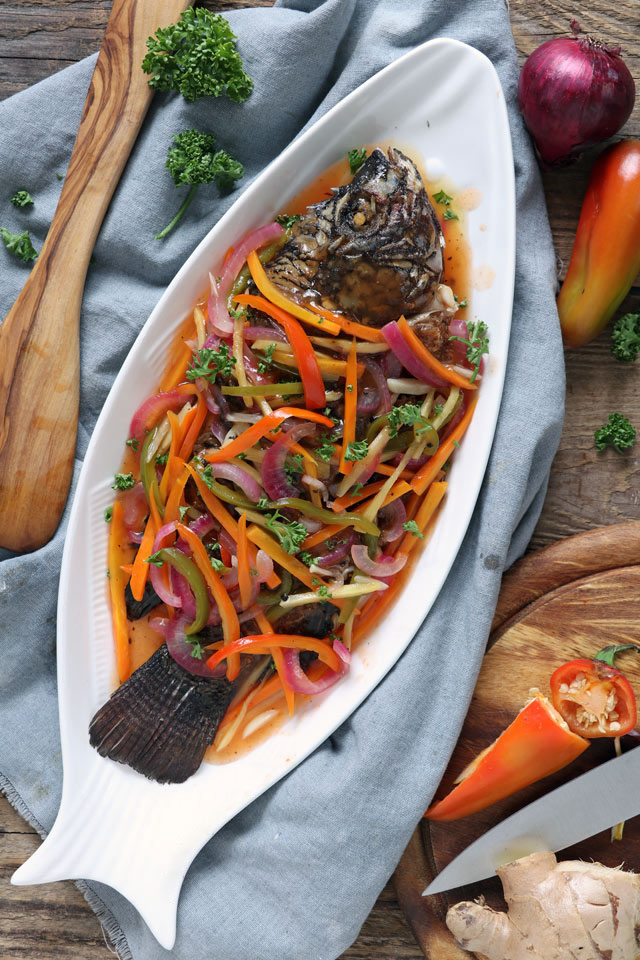
8) Escabeche
Escabeche is a delightful Filipino dish that blends sweet, sour, and savory flavors. This dish typically features fish, often fried to a crispy golden brown.
To prepare the fish, you should season it with salt and pepper. After that, coat it with cornstarch or flour before frying it in hot oil until it becomes crispy and golden.
The sauce is a key part of escabeche. You’ll need to sauté garlic, onions, and sometimes ginger in oil until they soften. Add vinegar, sugar, and water. Some versions include ketchup and soy sauce. Bell peppers and carrots often join the mix for extra flavor and bright colors.
Once the sauce is ready, let it boil and then simmer for a few minutes. Pour it over the fried fish. The fish will absorb the sauce, ensuring each bite is packed with flavor.
Escabeche is usually served with steamed rice, making it a satisfying meal. Enjoy the contrast of the crunchy fish and the rich, tangy sauce.
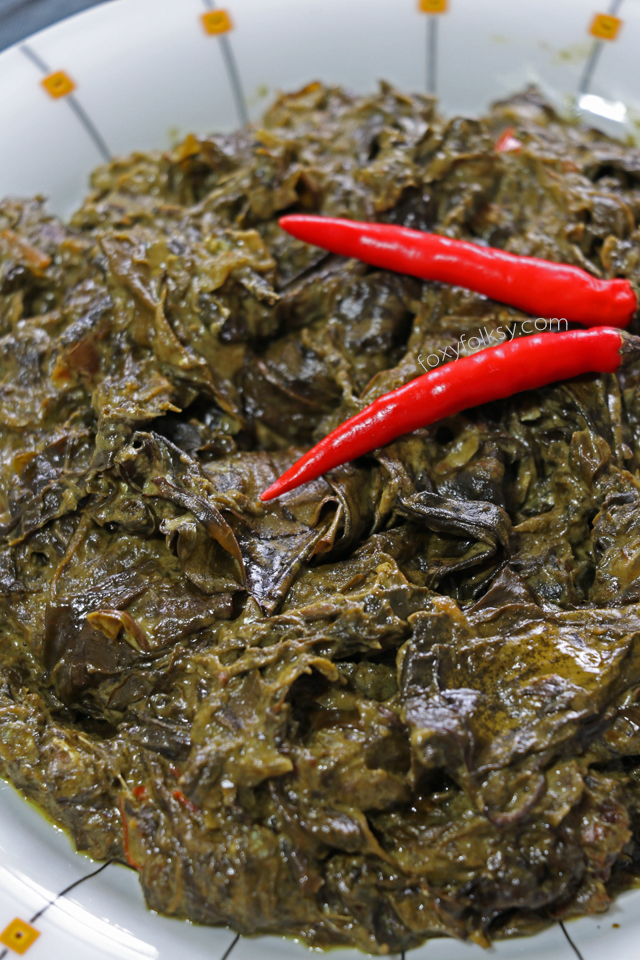
9) Laing
Laing is a dish from the Bicol region of the Philippines. It features dried taro leaves cooked in creamy coconut milk.
To make Laing, start by heating oil in a pan and adding chopped onions, garlic, and ginger. Cook until they are soft and fragrant. Adding pork or dried fish is common for extra flavor.
Once the pork or fish is cooked, pour in coconut milk and bring it to a simmer. When the coconut milk starts to boil, add the dried taro leaves.
The leaves should be gently pressed down to absorb the coconut milk. Let it cook without stirring for about 10 minutes. You can add red chilies for a spicy kick.
Continue to simmer the Laing until the leaves are tender and the sauce thickens. Adjust the seasoning with salt and pepper as needed. Laing is best enjoyed with steamed rice.

10) Pancit Palabok
Pancit Palabok is a popular Filipino noodle dish known for its vibrant sauce and rich flavor. It’s made with thin rice noodles, also known as bihon, which are topped with a savory sauce and a variety of garnishes.
The sauce is usually thickened with flour and flavored with shrimp broth, fish sauce, and ground black pepper. Some recipes also include shrimp bouillon for added depth. It’s simmered until it becomes thick and creamy.
To prepare Pancit Palabok, cook your noodles by boiling them until they are tender. Drain and set them aside.
Pour the sauce over the noodles, ensuring they are well-coated.
Garnish with toppings like crushed chicharon (fried pork rinds), tinapa flakes (smoked fish), hard-boiled eggs, and green onions.
For a bit of crunch, you can add deep-fried tofu cubes. The dish is often served with a slice of lemon or calamansi on the side for a touch of brightness.
Pancit Palabok is a flavorful dish that showcases the rich and diverse ingredients of Filipino cuisine. By following these steps, you can bring a taste of the Philippines to your kitchen.
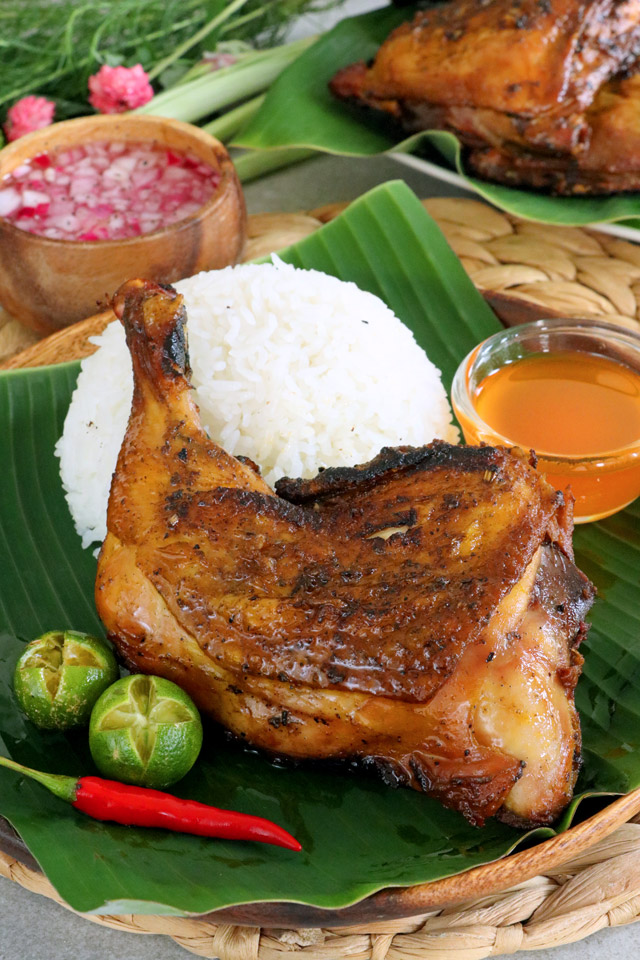
11) Chicken Inasal
Chicken Inasal is a popular Filipino dish known for its delicious flavor. This grilled chicken is marinated in a mix of vinegar, calamansi juice, garlic, ginger, lemongrass, sugar, salt, and pepper. The marinade gives the chicken a unique and tasty flavor that is both savory and slightly tangy.
After marinating for a few hours, the chicken is grilled to perfection. The grilling process adds a smoky taste that complements the marinade. While grilling, the chicken is basted with a special sauce made from margarine, annatto oil, salt, and lemon juice. This gives the chicken a beautiful color and rich flavor.
To get the best results, make sure to cook the chicken over medium heat and turn it frequently. This ensures the chicken is cooked evenly and stays juicy. You can also prepare Chicken Inasal in the oven if you prefer. Just roast it at 400°F, basting occasionally to keep it moist.
Serve Chicken Inasal with steamed rice and a dipping sauce made from vinegar, calamansi juice, soy sauce, and chili for an authentic Filipino meal. Your family will love this dish’s bold and zesty flavors. Enjoy the taste of the Philippines right at home!
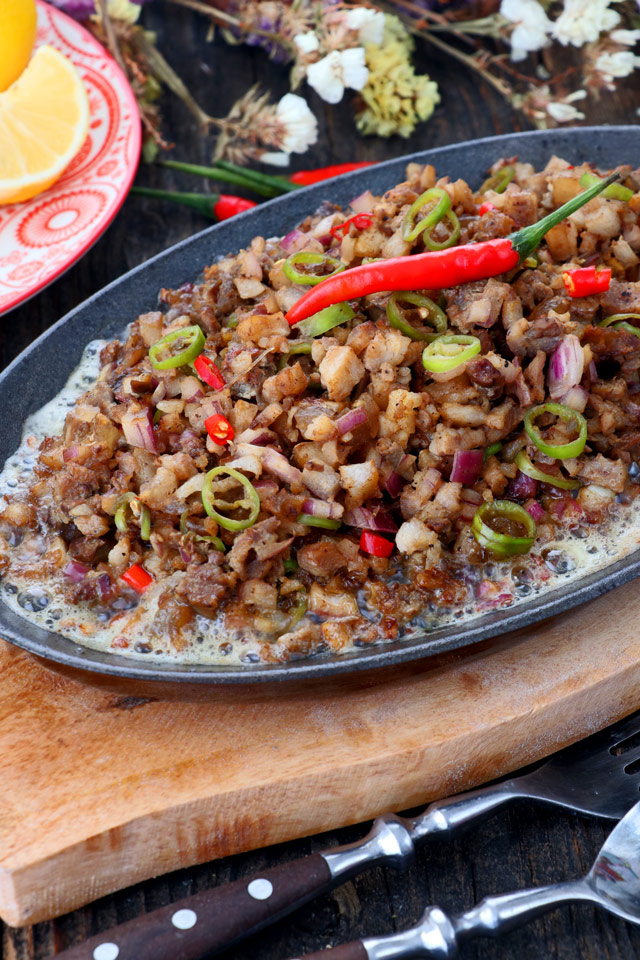
12) Sisig
Sisig is a popular Filipino dish known for its flavorful and crispy texture. The dish usually features grilled pork, often cheeks or belly, combined with minced chicken liver.
First, you prepare the pork by boiling it with soy sauce, vinegar, garlic, peppercorns, and bay leaves until tender. After boiling, grill the pork until it gets a nice char.
Next, finely chop the grilled pork and chicken liver. Combine the meat with chopped onions, chili peppers, and a touch of calamansi or lemon juice to add tanginess. Season generously with soy sauce and black pepper.
You serve Sisig on a sizzling platter to keep it warm and add a bit of butter or margarine for extra flavor. Some variations also include adding mayonnaise or egg on top.
This dish is best enjoyed hot, with steamed rice on the side. The mix of savory, spicy, and tangy flavors makes Sisig a must-try dish in Filipino cuisine.
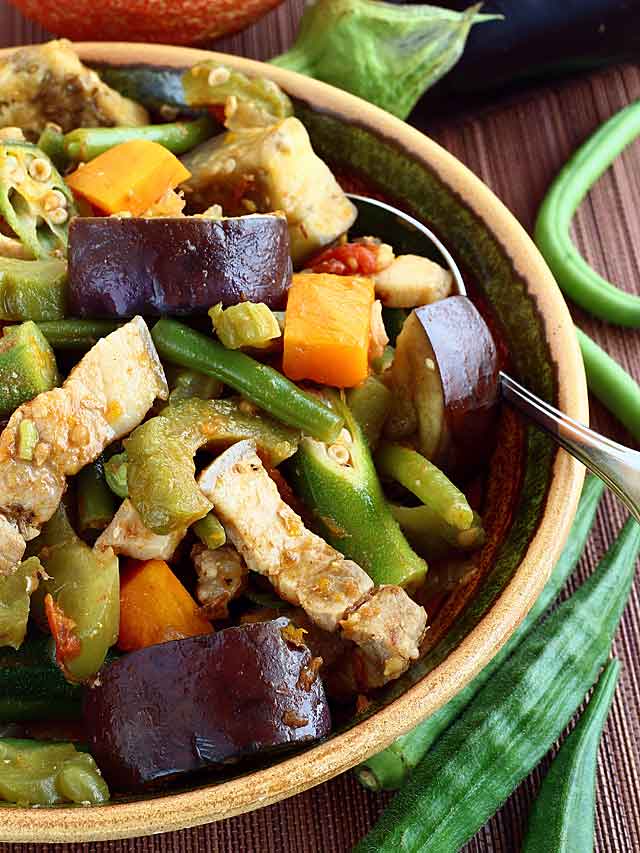
13) Pinakbet
Pinakbet is a popular Filipino vegetable stew. It usually features a mix of fresh vegetables like eggplant, okra, and bitter melon. These are cooked with pork belly or shrimp to add depth and flavor.
Begin by sautéing garlic, onions, and tomatoes in a pot. Cook until the tomatoes are soft. Add the pork or shrimp and cook until browned.
Next, pour in some water and bring it to a boil. Once it boils, lower the heat and let it simmer until the meat is tender. You can cover the pot during this process to speed up the cooking time.
Add the vegetables in stages, starting with the ones that take longer to cook, like the squash and bitter melon. Stir well and cook until all the vegetables are tender.
Season the dish with bagoong alamang (fermented shrimp paste) to give it an authentic Filipino flavor. Adjust the seasoning to taste, adding more salt or bagoong if necessary.
Serve your Pinakbet hot with steamed rice. This dish offers a rich combination of flavors, making it a comforting and nutritious meal. Enjoy the mix of tender meat and fresh vegetables with every bite.
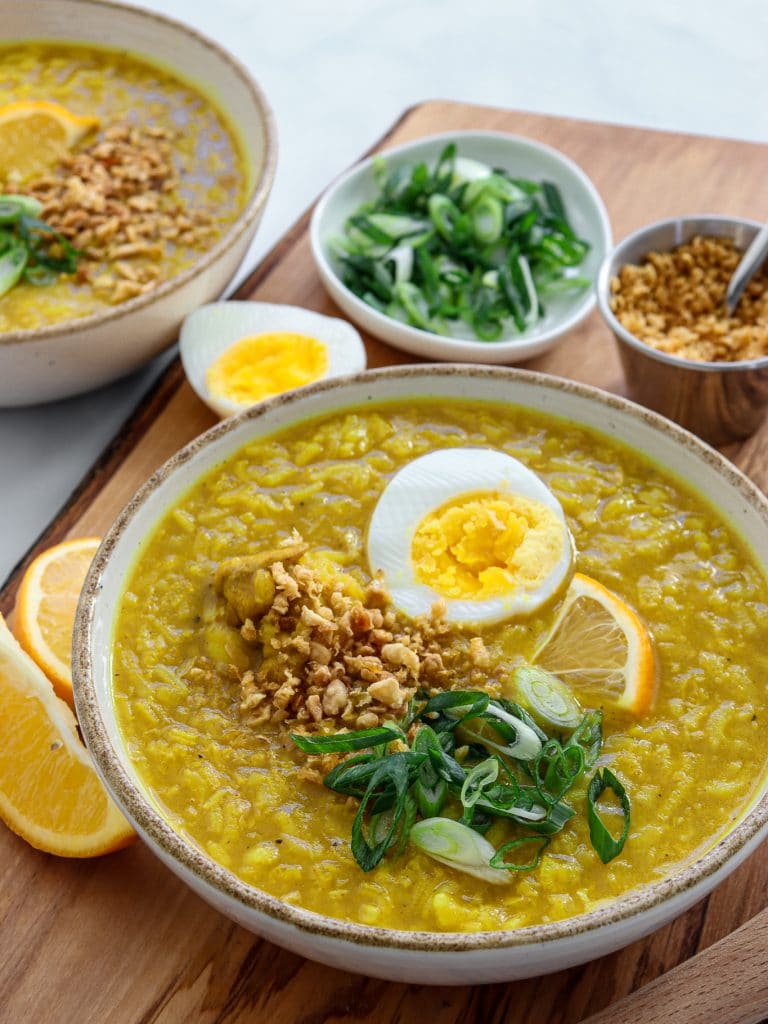
14) Arroz Caldo
Arroz Caldo is a popular Filipino rice porridge, perfect for breakfast or a comforting meal. It features a rich blend of chicken, rice, and ginger, creating a warm and savory dish.
To begin, heat some oil in a pot. Sauté garlic, onion, and ginger until fragrant. Add chicken pieces and cook until they turn golden brown.
Next, incorporate fish sauce and uncooked rice. Stir for a few minutes before adding water or chicken broth. Let it boil, then simmer. Cook until the rice achieves a creamy consistency.
Arroz Caldo is often garnished with hard-boiled eggs, scallions, and fried garlic. A squeeze of calamansi or lemon juice adds a fresh, tangy finish. This hearty, flavorful porridge is enjoyable any time you need a simple, soothing dish.
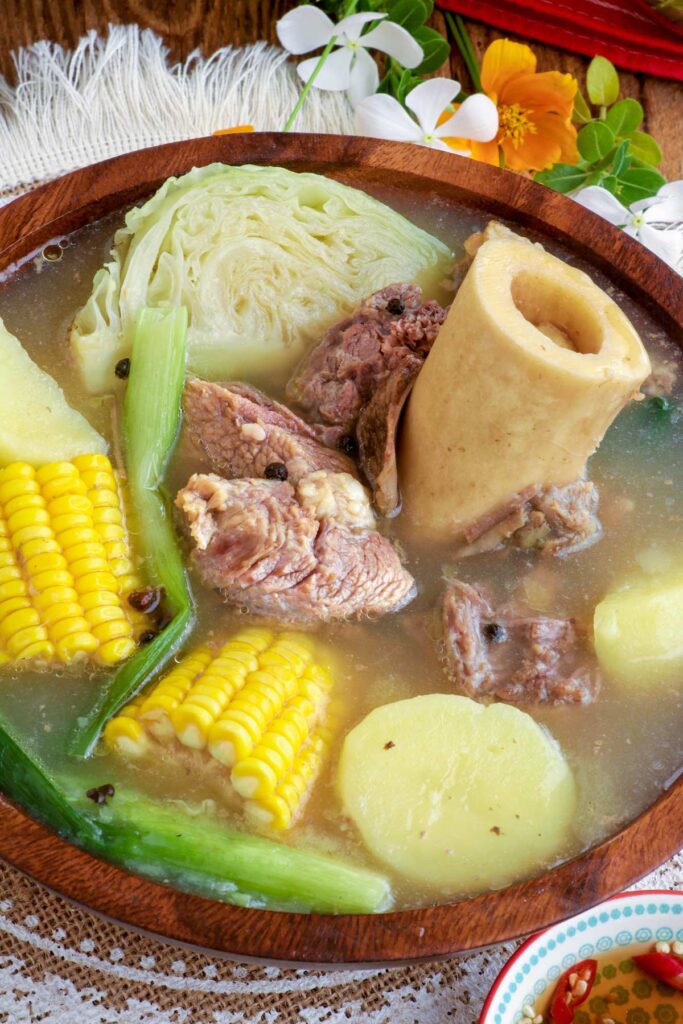
15) Bulalo
Bulalo is a comforting Filipino beef marrow stew. It’s made from simmering beef shanks and marrow bones until the meat is tender and the broth is flavorful.
Start by boiling marrow bones and beef shanks in a large pot of water. This process helps remove impurities. After a few minutes, take out the meat and bones, and rinse them under cold water to get rid of any scum.
Return the meat and bones to a clean pot, adding fresh water. Bring it to a boil again and skim off any scum that forms. Once the broth is clear, add onions, fish sauce, and whole peppercorns.
Cover the pot and let it simmer on low heat for 1.5 to 2 hours. This slow cooking makes the meat tender without falling apart. As the meat gets tender, add corn and let it cook until the corn is soft.
Season the broth with beef bouillon, salt, and pepper to taste. Some recipes also suggest adding potatoes for extra heartiness. Serve Bulalo hot, ensuring each bowl has a mix of tender beef, flavorful marrow, and rich broth.
This dish is perfect for cold weather or any time you crave a warm, hearty soup.
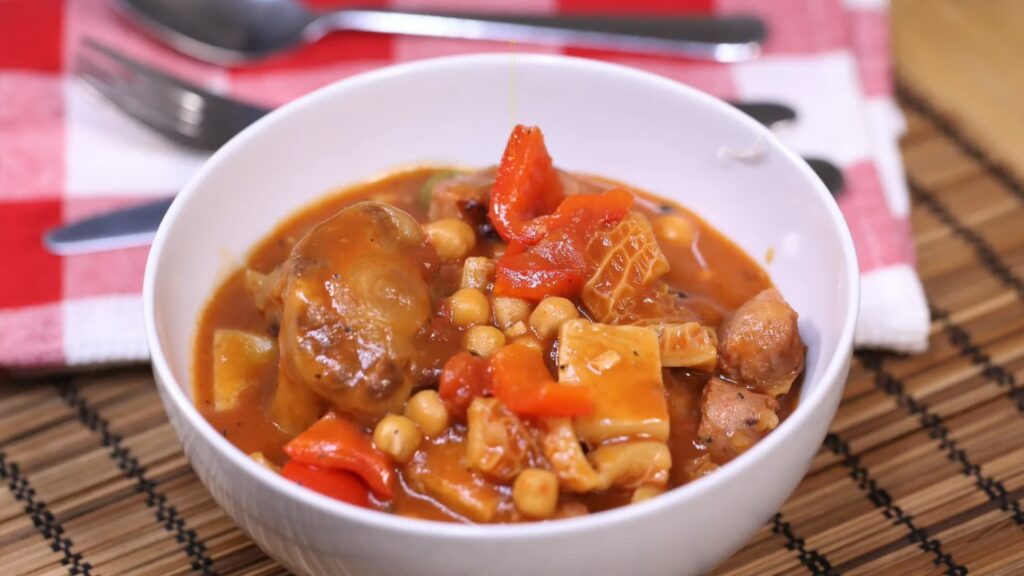
16) Callos
Callos is a traditional Filipino-Spanish dish known for its rich and hearty flavor. The main ingredients often include beef tripe, ox feet, and chorizo. These ingredients are slow-cooked until tender.
Start by cleaning the tripe well. Soak it in cold water for about an hour, then rinse under running water. In a pot, boil the tripe and ox feet for 10 to 15 minutes. Discard this initial boiling water to remove impurities.
Prepare the other ingredients like ham, chorizo, and garbanzos. Cut them into bite-sized pieces. In a pan, heat some olive oil and sauté onions until soft. Then, add tomato sauce and bring it to a boil.
Add the tripe, ox feet, ham, and chorizo to the boiling sauce. Stir in some broth, sherry, and a bay leaf. Season with paprika, salt, and peppercorns. Let it simmer until the flavors meld together.
Some recipes also call for carrots and potatoes to be added. These give the dish additional texture and flavor. Simmer until the vegetables are tender, and the sauce has thickened.
Serve hot with steamed rice or crusty bread. The rich, meaty flavors combined with the texture of tripe make Callos a unique and satisfying dish.
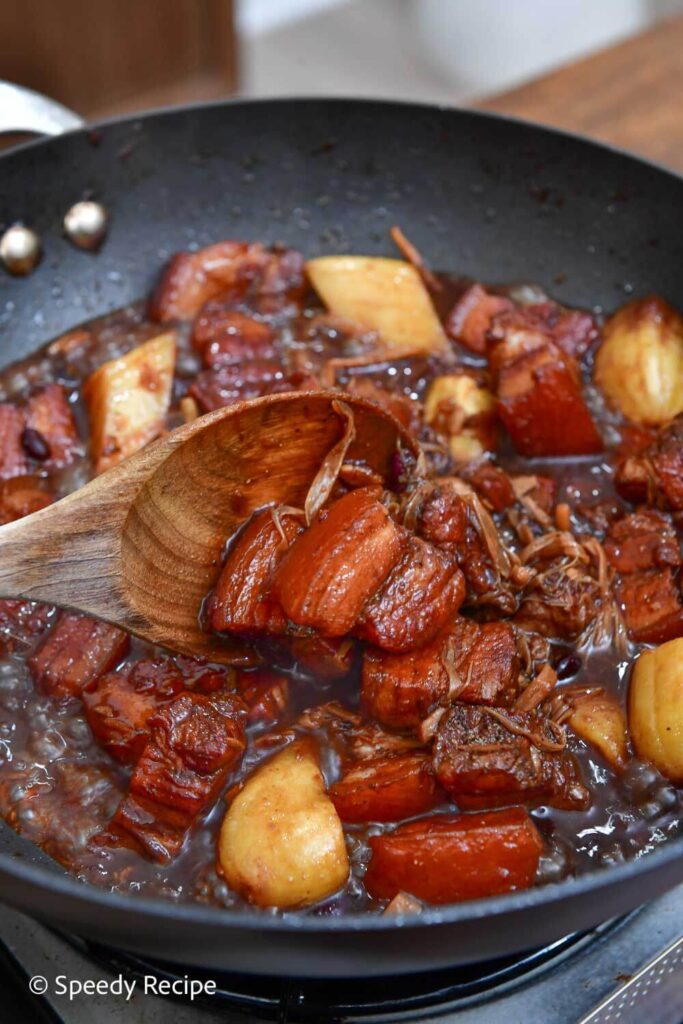
17) Humba
Humba is a popular Filipino dish from the Visayas region. It’s a flavorful pork stew that’s both sweet and savory. This dish is known for its tender pork and rich sauce.
To start, you’ll need pork belly, soy sauce, vinegar, brown sugar, and pineapple juice. These ingredients create a tasty blend of flavors. You will also need dried banana blossoms and salted black beans for extra depth.
Begin by cooking the pork in a pan until it turns golden brown. Transfer the pork to a pot and add the soy sauce, vinegar, pineapple juice, and brown sugar. Mix well and bring it to a boil.
Once boiling, reduce the heat, cover, and let it simmer. This helps the pork become tender and soak up the flavors. After about 45 minutes, add the banana blossoms and black beans. Continue to simmer until the sauce thickens.
Some recipes also include bay leaves and star anise, which add a unique aroma. Serve Humba with warm rice and enjoy the comforting taste of this Filipino classic.
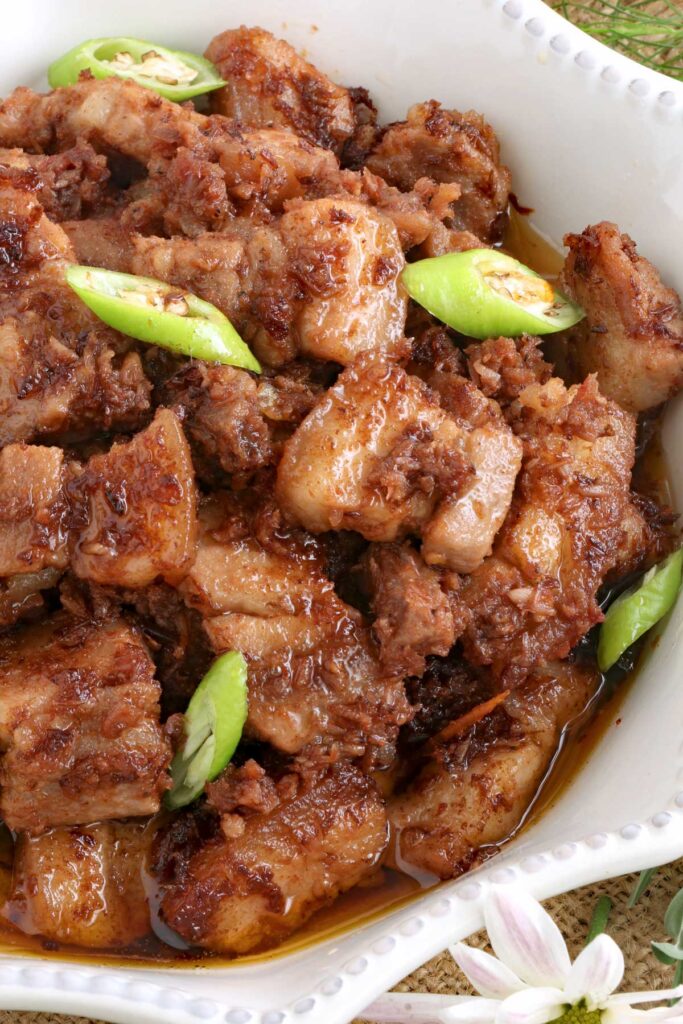
18) Binagoongan
Binagoongan is a traditional Filipino dish made with pork and shrimp paste. It’s a flavorful and savory meal that’s enjoyed by many.
You start by sautéing onions, garlic, and tomatoes until they soften. Then, add the pork and cook it until it’s browned. Stir in the shrimp paste and cook for a few minutes.
Next, pour in vinegar and let it simmer without stirring. This helps blend the flavors. Add a bit of water if needed, and cook until the pork becomes tender. Some recipes also add chili peppers for a spicy kick.
For a twist, you can also include coconut milk, which makes the dish creamy. If you prefer crispy pork, fry the pork pieces until golden and mix them into the sauce.
Binagoongan pairs well with steamed rice, making it a satisfying and hearty dish.
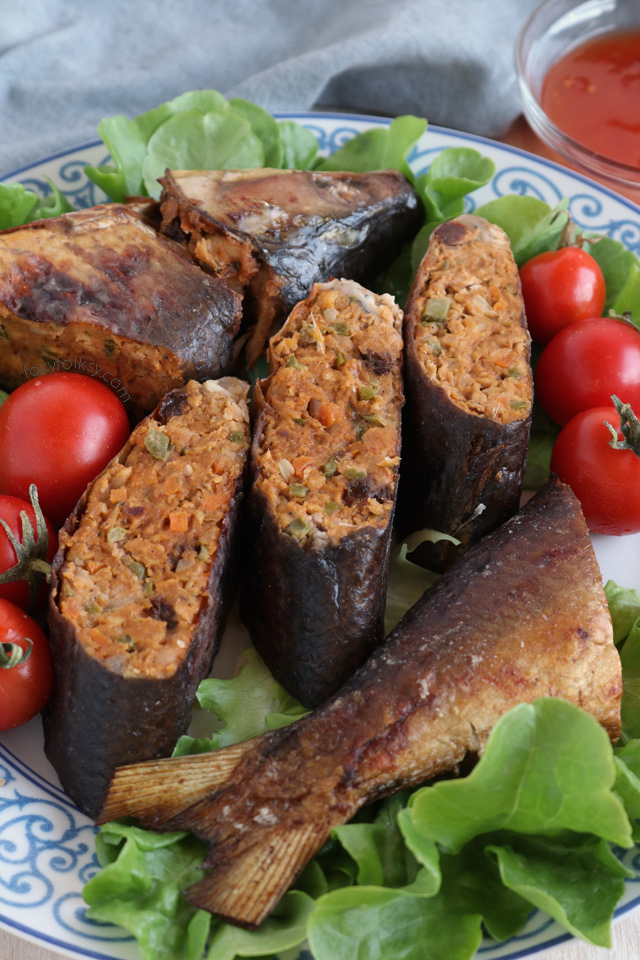
19) Relyenong Bangus
Relyenong Bangus, also known as stuffed milkfish, is a traditional Filipino dish that is sure to impress. You’ll need to start by removing the fish’s scales and cleaning it thoroughly. Carefully, debone the fish, keeping the skin intact.
Once the fish is prepared, cook the bangus meat until its color changes. Flake the cooked fish and remove any remaining bones. In a pan, sauté onions and garlic until they are soft.
Mix the flaked fish with ground pork, carrots, raisins, pickles, bell peppers, and beaten eggs. Season the mixture with salt and pepper to taste. Carefully stuff this mixture back into the fish skin.
Sew the opening with a needle and thread to keep the stuffing secure. Dredge the whole fish in flour until well-coated. Fry the fish until it is golden brown all over.
Let the fish cool before slicing. Garnish with fresh tomato slices, spring onions, or parsley. Serve with your favorite dipping sauce. This flavorful dish is perfect for special occasions.
Relyenong Bangus requires attention to detail, but the results are delicious and worth the effort. Enjoy crafting this Filipino culinary masterpiece!
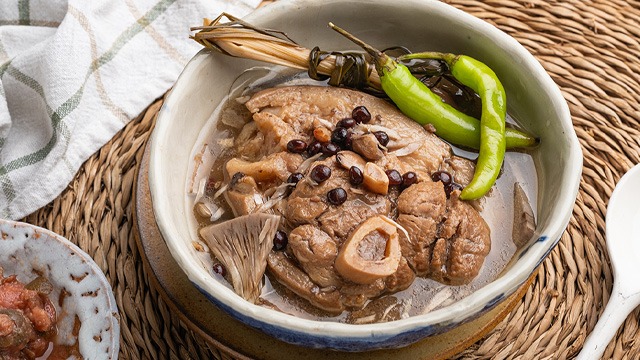
20) Kadyos, Baboy, Langka
Kadyos, Baboy, Langka (KBL) is a traditional Ilonggo stew known for its unique mix of flavors. The main ingredients are pork, pigeon peas (kadyos), and unripe jackfruit (langka). You will need to boil the pork until it’s tender. Grilling it first can add more flavor.
After boiling the pork, add the kadyos beans and langka cubes. Let them cook until the beans and jackfruit are tender. The broth gets its distinct taste from batuan, a souring agent. If you can’t find batuan, you can use a sinigang mix as a substitute.
To add more flavor, you can include lemongrass, onions, and finger chilies. Season the stew with salt and pepper. Some recipes also suggest adding kamote tops or spinach towards the end for a hint of green.
This hearty dish is perfect for family gatherings and serves as a comforting meal. The combination of tender pork, earthy pigeon peas, and the delicate flavor of the jackfruit makes KBL a standout among Filipino stews.
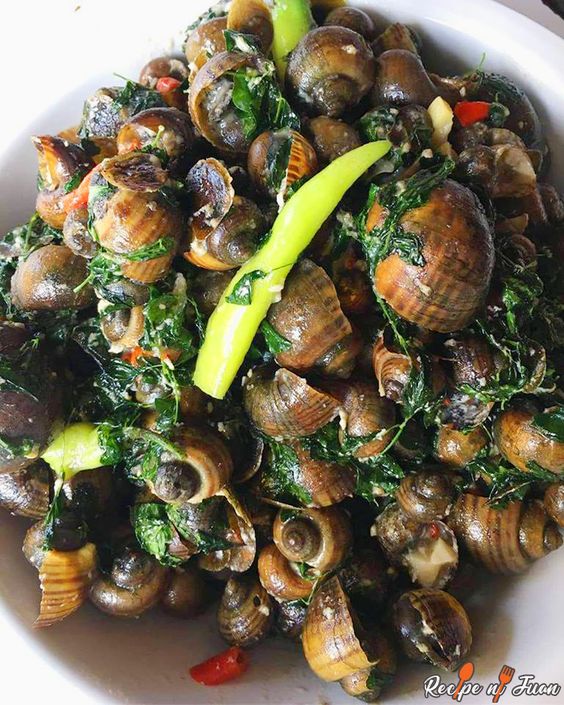
21) Ginataang Kuhol
Ginataang Kuhol is a traditional Filipino dish made with freshwater snails cooked in coconut milk. It is known for its rich and creamy flavor, thanks to the combination of spices and coconut milk.
To start, soak the snails in water for 2-3 hours. This helps to remove any impurities. After soaking, wash them thoroughly and tap the tails with a knife handle to loosen the meat.
In a large pot, heat oil over medium heat. Sauté garlic, onions, and ginger until they become fragrant. Add the snails to the pot and stir well.
Next, pour in the coconut milk. Let it simmer on low heat until the snails are tender. During the cooking process, you can add shrimp paste and chili peppers for an extra kick.
Make sure to cover the pot tightly while cooking to keep the flavors inside. When the snails are tender, you can add coconut cream to make the dish even creamier.
Serve Ginataang Kuhol hot with steamed rice. This dish offers a delightful mix of flavors and textures, making it a unique addition to your meal.
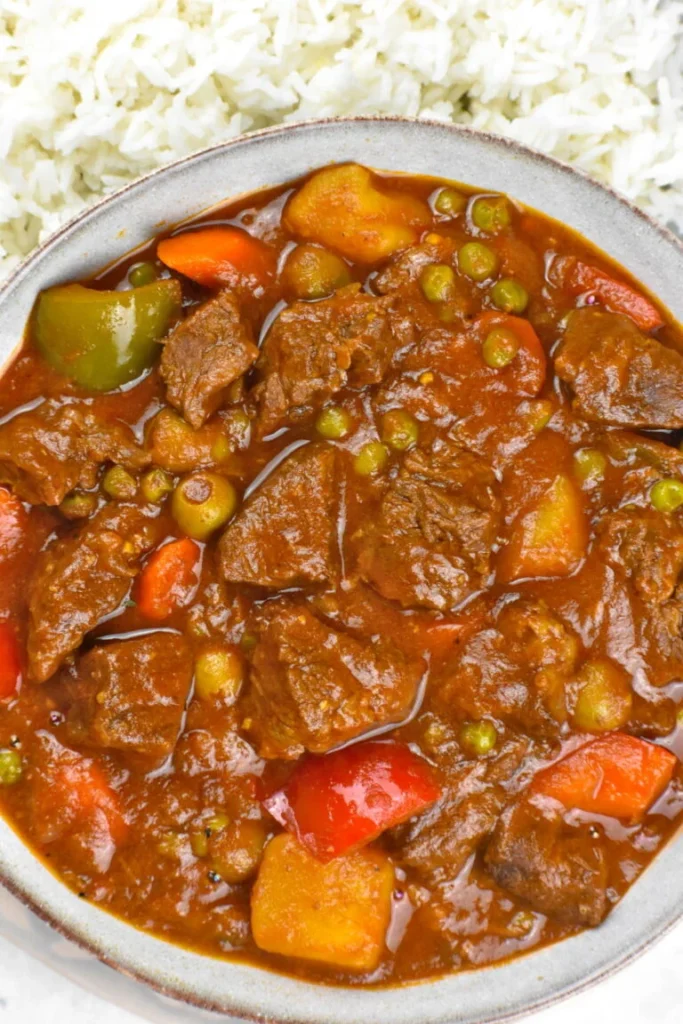
22) Caldereta
Caldereta is a beloved Filipino stew known for its rich flavors and hearty ingredients. The dish often features tender beef cooked in a savory tomato sauce.
You will start by marinating beef chunks in a mix of vinegar, crushed peppercorns, and garlic. After marinating, the beef is browned in a pot with sautéed onions and garlic.
Next, add tomato sauce and beef broth to the pot. Let the stew simmer until the beef becomes tender. This may take about 30 minutes in a pressure cooker or 1-2 hours in a regular pot.
Potatoes and carrots are also key ingredients. You should brown them lightly in oil before adding to the stew. This step helps to enhance their flavor and texture.
Some recipes call for liver spread to be included. Adding this gives the stew a richer, more complex taste. Make sure to stir it well into the sauce.
Don’t forget to adjust the seasoning. Soy sauce or fish sauce can boost the umami flavor. Finally, let everything cook together until the vegetables are tender. Serve your Caldereta hot with steamed rice.
Enjoy this traditional Filipino dish that brings a taste of the Philippines to your table.
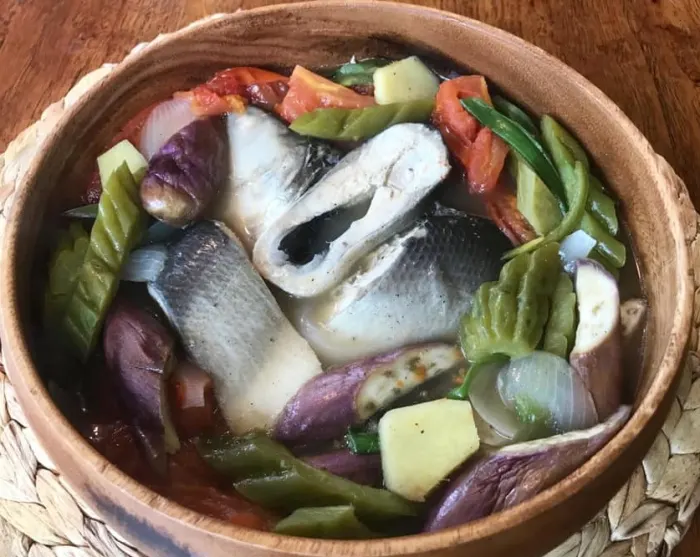
23) Paksiw na Isda
Paksiw na Isda is a Filipino dish that uses vinegar to cook fish. This method of cooking helps to preserve the fish and bring out a unique tangy flavor. You’ll often see this dish made with bangus (milkfish) or other types of fish.
To start, heat a pan and pour in vinegar and water. Add salt and whole peppercorns. Bring the mixture to a boil. Once boiling, place your fish in the pan along with some ginger, garlic, and onions.
Next, add bitter gourd and finger chili to the pan. These ingredients add both flavor and a bit of heat. Cover the pan and let it simmer on low to medium heat for about 12 to 15 minutes.
After simmering, your Paksiw na Isda is ready to serve. This dish pairs well with steamed rice. The tangy and savory flavors will make your meal truly special. Enjoy!
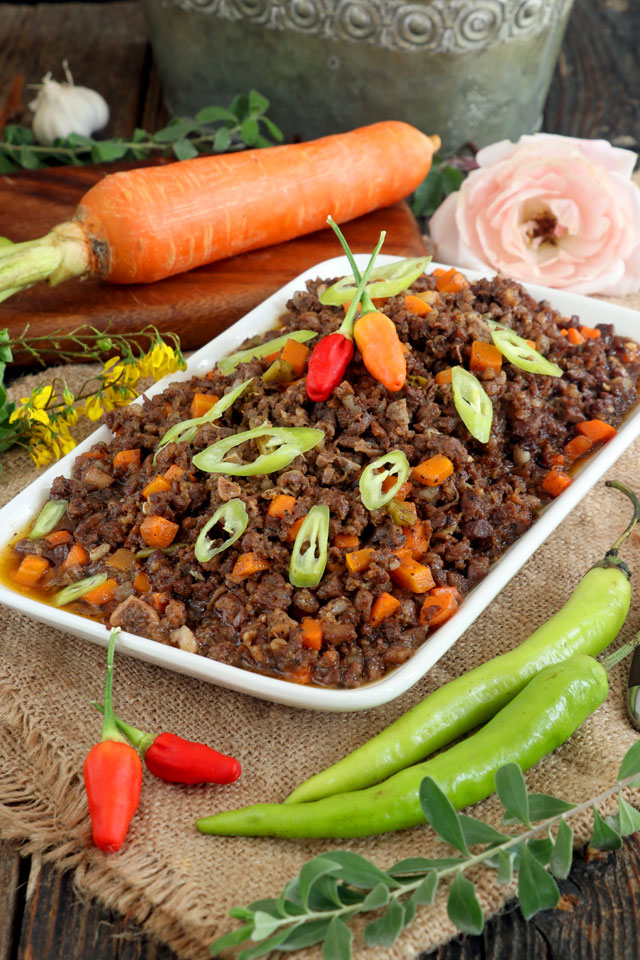
24) Bopis
Bopis is a popular Filipino dish made from pork lungs and heart. This savory and spicy dish is known for its rich flavors and distinct texture.
To start, wash the pork lungs and heart thoroughly. Boil them in water with vinegar and salt until tender. Let them cool and dice into small pieces.
Sauté garlic and onions in oil until fragrant. Add in the diced lungs and heart. Cook until they turn brown. Pour vinegar and let it simmer without stirring. Season with salt and pepper.
Next, add carrots, bell peppers, and chili peppers. Stir well. Let the mixture cook until the vegetables are tender. You can also add liver spread for extra flavor and richness.
Serve bopis with steamed rice. The bold flavors and tender meat make this dish a favorite in many Filipino households. It’s perfect for those who enjoy spicy and savory dishes with a unique twist.
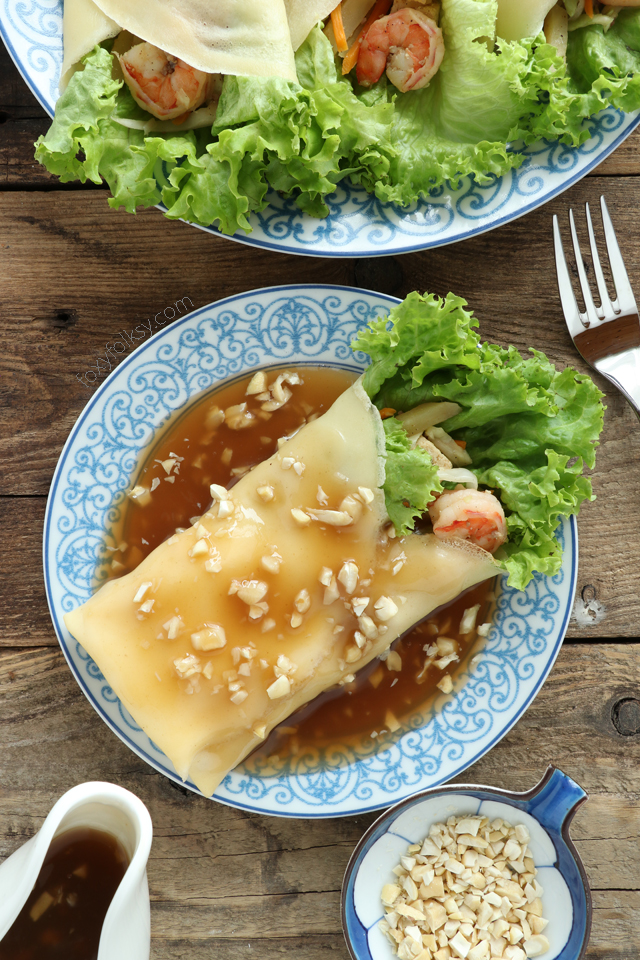
25) Lumpiang Ubod
Lumpiang Ubod is a classic Filipino dish known for its fresh and crunchy texture. It is made with hearts of palm, known locally as “ubod.” This ingredient gives the roll its unique taste and delicate crunch.
To make Lumpiang Ubod, you start with a soft crepe wrapper. Lay a piece of lettuce on the wrapper and scoop some ubod filling, which might also include vegetables and sometimes chicken or shrimp. Gently wrap this mixture into a neat roll.
The sauce is just as important as the filling in Lumpiang Ubod. A savory sauce made from a mix of water, soy sauce, brown sugar, and garlic is poured over the assembled rolls. Some variations include crushed peanuts to add a nutty flavor and a bit of texture.
Lumpiang Ubod is a refreshing dish that is often served during special events and gatherings. It stands out for its mix of fresh ingredients and savory-sweet sauce. This dish showcases Filipino cuisine’s balance of flavors and textures. It’s a dish you should definitely try if you want to experience the unique flavors of the Philippines.
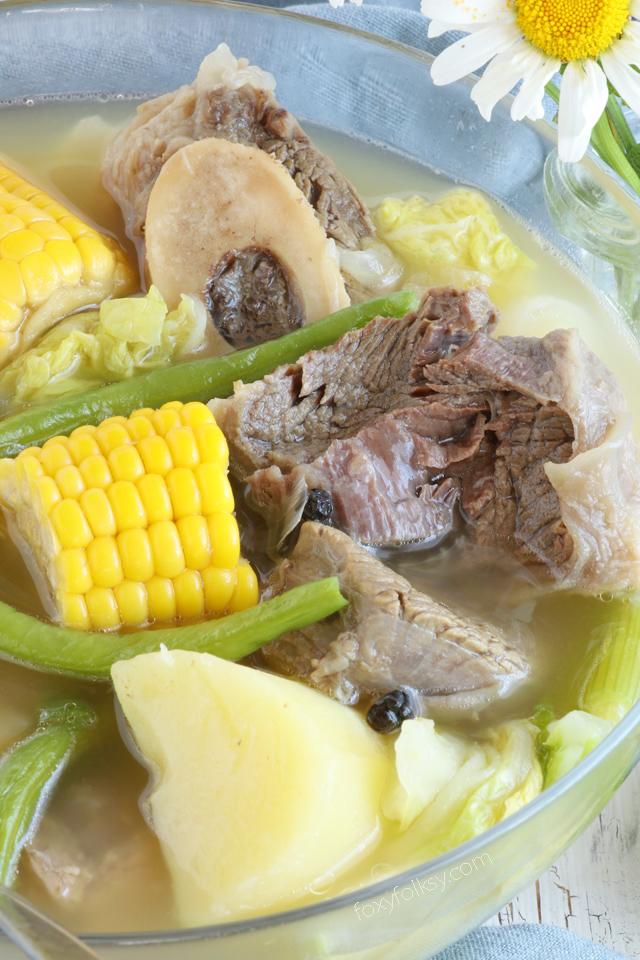
26) Nilagang Baka
Nilagang Baka is a Filipino beef soup that’s both comforting and flavorful. It’s made by boiling beef shanks, tendons, and vegetables.
Start by bringing beef shanks and tendons to a boil in a large pot of water. Skim off any impurities that float to the surface.
Add onions, peppercorns, and fish sauce to the pot. Lower the heat and let it simmer until the beef is tender.
While the beef cooks, you may need to add more water to prevent it from drying out. Once tender, add carrots, potatoes, and cabbage. Simmer until the vegetables are fork-tender.
Serve the soup hot, making sure each bowl has a good mix of meat and vegetables. This dish is best enjoyed with rice on the side.

27) Balut
Balut is a popular delicacy in the Philippines that consists of a fertilized duck egg with a partially developed embryo inside. It is enjoyed by many for its unique taste and texture.
To prepare balut, select duck eggs that are between 19 to 22 days old. Wash the eggs thoroughly to ensure they are clean before cooking.
Boil the eggs on medium-high heat for about 35 to 40 minutes. Once cooked, the eggs can be eaten as is or with a sprinkle of salt and a dash of vinegar.
Balut is often considered to be an aphrodisiac and is believed to be high in protein. It is also thought to have various health benefits.
Though it may be unusual to some, balut holds a special place in Filipino cuisine and is enjoyed as a savory snack or even an entrée.
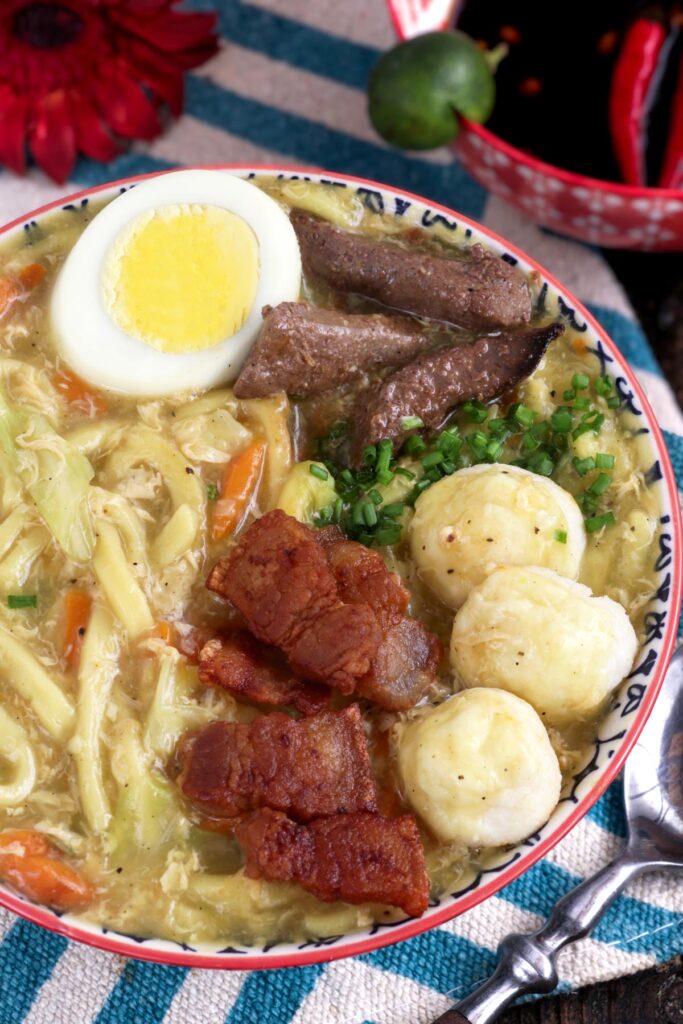
28) Batangas Lomi
Batangas Lomi is a comforting noodle soup from the Philippines. It features thick, chewy lomi noodles in a rich, flavorful broth.
To make Batangas Lomi, start by sautéing garlic and onions in oil until they become soft. Add sliced pork and cook until browned. You can also add pork liver for extra flavor.
Next, pour in fish sauce and soy sauce. Stir to combine the ingredients well. Add pork bouillon cubes and water. Bring the mixture to a simmer.
Add the lomi noodles and cook until tender. Make a slurry with cassava starch or cornstarch and water. Slowly pour it into the soup, stirring continuously until the broth thickens.
Finally, add beaten eggs while stirring. Season with salt and pepper to taste. For serving, you can top the lomi with various ingredients like crispy pork rinds, halved boiled eggs, and sliced meatballs.
Batangas Lomi is best enjoyed hot. It’s a delicious, filling meal that brings authentic Filipino flavors to your table.
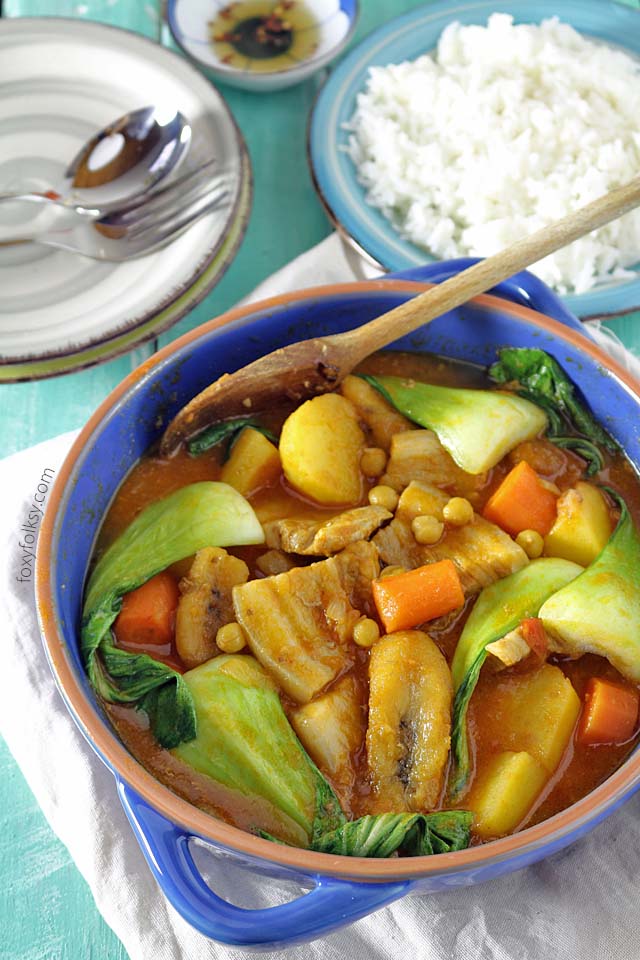
29) Pochero
Pochero is a hearty Filipino stew that’s packed with flavor. It combines pork, vegetables, and a rich tomato sauce. The ingredients give it a unique taste that makes it stand out from other stews.
To make Pochero, start by cooking pork until it’s browned. Then, add fish sauce, whole peppercorns, and tomato sauce. Let it simmer until the pork is tender.
Next, add potatoes, plantains, chickpeas, and cabbage. These vegetables soak up the rich flavors of the stew. Don’t forget the long green beans for added texture.
This dish is often served with rice, a staple in Filipino cuisine. The combination of tender meat, flavorful sauce, and mixed vegetables makes Pochero a complete meal.
You’ll appreciate the balance of flavors in Pochero. The sweetness of the plantains, the savory pork, and the tangy tomato sauce create a comforting dish that’s perfect for any occasion.
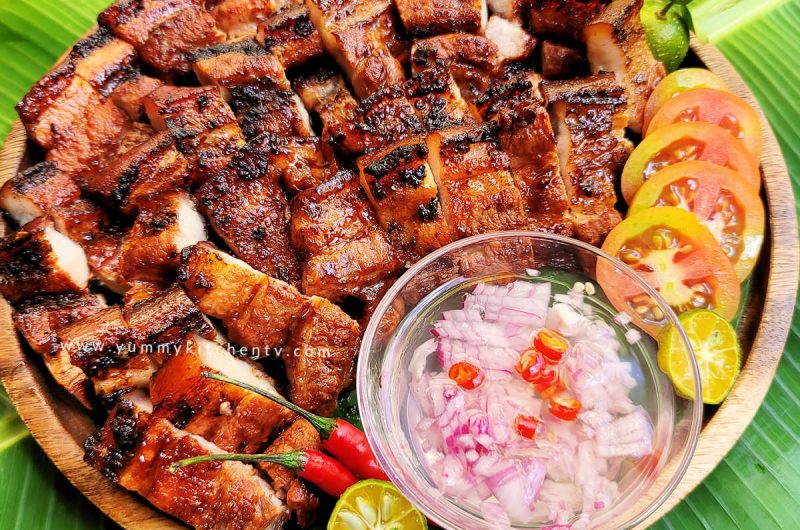
30) Inihaw na Liempo
Inihaw na Liempo is a popular Filipino dish made with grilled pork belly. It’s known for its juicy, flavorful meat and charred edges.
To start, you need to marinate the pork belly for at least three hours. Common ingredients for the marinade include soy sauce, calamansi juice, garlic, chili peppers, and brown sugar. This blend gives the meat a savory and slightly sweet taste.
When grilling, make sure to preheat your grill. Place the pork belly slices on the grill and let them cook for about 3-4 minutes on each side. You want the meat to be slightly charred but not burned.
Basting the pork belly with the marinade while grilling helps to keep it moist and enhances the flavor. Make sure your skewers are soaked in water if you are using bamboo ones to prevent them from burning.
After grilling, let the meat rest for a few minutes before serving. This allows the juices to redistribute within the meat, making each bite deliciously tender and flavorful. Enjoy it with rice and a dipping sauce on the side for a complete meal.
Traditional Filipino Cooking Techniques
Filipino cuisine features a variety of cooking techniques that enhance the rich and diverse flavors of its dishes. Key methods include slow simmering and braising, grilling and roasting, and stir-frying and sautéing.
Slow Simmering and Braising
Slow simmering and braising are fundamental to many Filipino dishes. These methods involve cooking food at low temperatures for extended periods, allowing flavors to meld and proteins to become tender.
Adobo, a popular dish, uses a marinade of vinegar, soy sauce, garlic, and bay leaves to flavor chicken or pork. The cooked meat is simmered slowly until tender. This technique not only infuses the meat with robust flavors but also makes it incredibly succulent.
Sinigang, a sour soup commonly made with pork, shrimp, or fish, benefits from slow simmering too. The tamarind-based broth becomes richly flavored as it slowly cooks with vegetables like radishes and green beans. The extended cooking time softens the vegetables and melds the sour and savory tastes beautifully.
Grilling and Roasting
Grilling and roasting are essential for preparing many traditional Filipino dishes. These methods concentrate flavors and create delightful textures through caramelization and charring.
Lechon, or roasted pig, is a centerpiece at many celebrations. The pig is seasoned, skewered, and roasted over an open fire, resulting in crispy skin and juicy meat. This technique requires careful, slow turning to cook the meat evenly without burning the skin.
Inihaw na Isda (grilled fish) and Inihaw na Manok (grilled chicken) are also popular. These dishes are typically marinated in a mix of vinegar, soy sauce, garlic, and spices before grilling. The hot grill imparts a smoky flavor and textural contrast that makes these dishes memorable.
Stir-Frying and Sautéing
Stir-frying and sautéing are quick cooking methods that are frequently employed in Filipino kitchens. These techniques help to develop flavors rapidly while preserving the freshness and crunch of vegetables.
Monggo Guisado, a mung bean stew, starts with sautéing garlic, onions, and tomatoes. This base is then combined with the pre-cooked mung beans and other vegetables like spinach or squash to create a flavorful and hearty stew.
Giniling na Baboy (ground pork sauté) incorporates ground pork with vegetables such as potatoes, carrots, and peas. The ingredients are quickly stirred in a hot pan with aromatics until cooked through, making it a convenient and tasty dish.
Pancit, a noodle stir-fry, combines pre-cooked noodles with a medley of vegetables and meat. This dish is known for its rapid cooking process, ensuring that the vegetables remain crisp and the flavors are vibrant.
Unique Ingredients in Filipino Cuisine
Filipino cuisine is known for its diverse use of ingredients that give the dishes their distinctive flavor profile. You will find a variety of exotic fruits and vegetables, unique spices and condiments, and specialty meats and seafood.
Exotic Fruits and Vegetables
One staple in Filipino dishes is the use of green mangoes. These sour fruits are often made into salads or used as a tangy dip.
Another key ingredient is kangkong (water spinach), frequently found in soups and stir-fries.
Ube, a purple yam, stands out in many desserts, providing a vibrant color and sweet flavor.
Other unique vegetables include ampalaya (bitter melon) and malunggay (moringa), which add distinct tastes and nutritional value to various dishes.
Distinctive Spices and Condiments
Filipino cooking often utilizes calamansi, a small citrus fruit that adds a zing to marinades and sauces.
Soy sauce and vinegar are fundamental in many recipes, offering a balance of salty and sour.
Fish sauce (patis) is another critical condiment, imparting a deep umami flavor.
Bagoong (fermented shrimp paste) brings a salty richness to dishes like kare-kare.
Lastly, garlic, onions, and ginger are indispensable, providing aromatic base layers in many Filipino recipes.
Specialty Meats and Seafood
Lechon (roasted pig) is a celebrated centerpiece at many Filipino feasts.
Tocino is sweet-cured pork often served at breakfast.
In coastal areas, seafood like prawns, crabs, and various fish are crucial. Sinigang na sugpo, a tamarind-based prawn soup, is a popular dish.
Balut, a fertilized duck egg, though an acquired taste, is widely known.
These specialty meats and seafood highlight the richness and diversity of Filipino culinary traditions.
Cultural Significance of Filipino Dishes
Filipino dishes play a crucial role in many aspects of life, from grand festivals to intimate family gatherings. They reflect the heritage and adaptability of the Filipino people.
Festivals and Celebrations
In the Philippines, festivals and celebrations are vibrant events featuring diverse and flavorful dishes. Lechon, a whole roasted pig, is often the centerpiece at major events like Fiesta and Christmas. This dish symbolizes prosperity and unity.
Bibingka and puto bumbong, traditional rice cakes, are staples during the Simbang Gabi, a series of evening masses leading up to Christmas. These dishes connect people to their faith and community.
Such dishes are not just food but are integral to the festivities and rituals.
Family and Social Gatherings
Food is central to Filipino family and social gatherings. At family reunions, dishes like adobo and sinigang are commonly served. These meals bring everyone together, creating a sense of belonging and sharing.
Lumpia, Filipino spring rolls, are popular at birthday parties and other celebrations. They are easy to share and enjoy.
Sharing food during these times strengthens family bonds and fosters tradition.
Regional Variations
The Philippines has many regions, each with its own specialties. In Bicol, you’ll find Bicol Express, a spicy and creamy pork dish with coconut milk and chili. This reflects the region’s affinity for bold flavors.
In the Ilocos region, pinakbet, a mixed vegetable dish with bagoong (fermented fish paste), showcases the use of local produce.
Each region’s unique dishes represent its local culture, history, and available ingredients. This variety shows the richness of Filipino cuisine and its adaptability to different environments and tastes.








